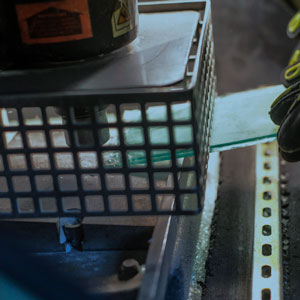As you are aware every windscreen we make has to meet the rigorous safety standards stipulated in the United Nations
ECE R43 homologation programme. And because at Guardian Automotive, we take safety very seriously, we do much more
than merely comply with the regulations.
All Guardian Automotive Replacement Glass is fully tested to ensure that it complies fully with the ECE R43 standard
for safety glazing materials and their installation on vehicles. In a range of tests, many of which are carried out
daily, we assess optics, light transmission, light stability, temperature and fire resistance, humidity, impact and
abrasion. And we go further. For instance, every day we carry out twice the number of required tests – so that
you can be sure that you are providing your customers with the highest quality product.
Active support
Our technical support certainly goes further than testing alone – as you would expect from a world leading
supplier. As the market introduces new car models and advanced designs – Guardian Automotive invests in the
development of new models and solutions – to help keep your business up-to-date. In fact, we introduce at
least one new product every day, fully tested and ready to go. And if you need help or advice, all you have to do is
to contact us.
There are many cars on the road – and we want to make sure they keep running safely. Of course, on-time
delivery is always important, but the key requirement is product quality and safety. After all, every Guardian
windscreen you install should enhance your reputation – and ours. It is for this reason that we set out to
create quality products that you – and your customers - can depend on, every time.
Guardian Automotive certainly goes beyond the requirements of the ECE R43 standard: “Having been part of the
Automotive supply chain for many years, we know the European industry’s high standards. This is why we are
constantly investing in a full programme of monthly, six monthly and yearly tests, carried out both internally and
externally. This enables us to comply with these standards – and exceed them. Our commitment is that we will
deliver total quality, compliance and consistency of our products – every day” says Sergio
Múgica, European Auto Quality Manager at Guardian Automotive.
TORQUE TEST
Purpose
Assess adhesion between mirror button and the windshield.
Means
- Torque wrench
- Mirror button template
- Windshield
Procedure
- Install the correct template on the torque wrench.
- Put the torque wrench on the mirror button.
- Turn the mirror button with the wrench up to its failure.
- Check in the dial the maximum torque resisted.
Acceptance criteria
Torque value over minimum standard value.

Picture description
You can see the operator using the torque wrench. The operator tries to turn the mirror button using a wrench
(holded by a special template). When the mirror button breaks, you can see in the dial the highest torque
that the mirror button has resisted.
PUMMEL TEST
Purpose
Assess adhesion resistance of laminated glass.
Means
- Freezer
- Hammer machine
- Laminated glass sample (300x150mm)
- Pummel
Procedure
- Freeze the glass sample to -18ºC
- Take the sample and place it into the hammer machine.
- Pummel the sample repeatedly.
- Check the amount of remaining glass adhered to the PVB.
Acceptance criteria
According to calibrated standards.

Picture description
You can see the glass sample being hammered by the machine. Operator is holding the sample and, at the end, he will compare to a pattern in order to asses the adhesion of laminated glass